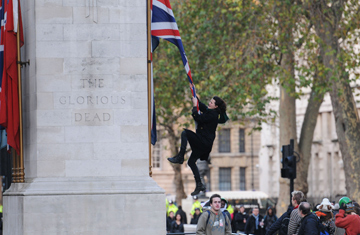
Charlie Gilmour, son of Pink Floyd guitarist David Gilmour, has apologized for climbing the Cenotaph war memorial during London's student protests
A series of icons shape and symbolize the way Britons traditionally see themselves: the domed helmet still worn by police on the beat that evokes a heritage of friendly policing; a royal family still riding high in public affections; and the royals' Phantom VI Rolls-Royce, still going strong after 33 years, to name just a few. To those historic emblems you might well add the country's tradition of self-effacing philanthropy, as personified by Pink Floyd guitarist David Gilmour, who quietly sold his London townhouse to fund a development providing accommodation to the homeless. Now U.K. authorities are investigating student riots that on Dec. 9 engulfed a Rolls-Royce carrying the Prince of Wales and his wife Camilla and later led to the arrest, on suspicion of violent disorder and criminal damage, of Gilmour's 21-year-old adopted son Charlie. Their deliberations could impact the future direction of policing — and forever change Britain's self-image.
That image does not include rioting. "It was troublemakers that did it," a London cab driver insists, "from Europe."
Ask any Briton about last week's rampages — offshoots of peaceful protests against increases to university tuition fees — and he or she will most likely tell you they were an aberration, out of keeping with the British national character, "the sort of thing they do in France," as the cabbie adds. Some British newspapers have reinforced this patriotic denialism, reporting that protesters traveled from abroad to foment unrest. "Anarchists from Argentina, Germany, Italy and Latvia Plotted the London Mayhem," the Daily Mail tabloid reassured its readers in a headline on Dec. 13.
But photographs published by the Mail and other newspapers of Gilmour fils, an undergraduate at the elite Cambridge University, swinging from the Union flag atop the Cenotaph war memorial in Whitehall, undermined the idea that all the trouble was imported. Indeed, although the security services have long been aware that hard-core protesters, sometimes linked to the antiglobalization movement, cross borders to take part in protests, there's little doubt that Britain is capable of growing its own demonstrators, whether they are scions of multimillionaire musicians or from humbler stock. And with the country's austerity budget beginning to bite, there will be no shortage of grievances to draw Britons onto the streets.
The urgent question for police and politicians is how to facilitate future peaceful protests while preventing the sort of violence that left the Duchess of Cornwall cowering in a car's footwell. The head of London's Metropolitan Police, Sir Paul Stephenson, apologized to Prince Charles and is rumored to have offered his resignation over mistakes that placed the future King and his wife in jeopardy. Home Secretary Theresa May acknowledged that an assailant made "contact" with Camilla — unconfirmed reports suggest the Duchess was poked with a stick through the car window. Internet footage shows a policeman protected only by his bobby's helmet ineffectually trying to keep rioters away from the car, although armed royal protection officers would have been nearby.
May suggested that in the future, police might deploy a water cannon, used in Northern Ireland but never in Britain, to control violent protests, and the Metropolitan Police confirmed it is liaising with colleagues in Northern Ireland about their use. But May also told MPs the deployment of water cannon was not yet approved in England and Wales, while Sir Hugh Orde, the former chief constable of the Northern Irish police and now the president of the Association of Chief Police Officers, representing 42 police forces in the U.K., was quick to dismiss the idea. "Small groups of very violent people have embedded themselves in large groups of very peaceful people and to try to use water cannon in that situation would be very difficult and would upset an awful lot of people," he told the BBC in a Dec. 13 interview.
He would have been keenly aware that police have come under criticism not only for letting the Dec. 9 demonstration run out of control but also for trying to contain protesters too robustly. One demonstrator, Alfie Meadows, 20, underwent emergency brain surgery after allegedly being hit on the head with a police truncheon as he sought to escape from a so-called kettling area, a police cordon used to contain demonstrators, often for hours. Kettling, like use of a water cannon, makes no distinction between law-abiding protesters and those intent on causing damage.
"Britain and its best policing traditions are envied around the world because we don't generally resort to the kind of military tactics used by less democratic regimes," said Shami Chakrabarti, the director of human-rights organization Liberty, in the aftermath of the rioting. The police "will look across the board and they will be making operational decisions," May told Sky News on Sunday. "What is absolutely crucial is that for those who did inflict criminal damage, for those who were breaking the law, that they should now feel the full force of the law."
The debate about whether tougher policing calms or encourages violence — and about how to retain a British flavor to policing — marks Britain's dawning recognition of harsh new realities. Some of the country's ideas of itself may no longer stand up to close examination. Some traditions may not survive. The Home Secretary already hinted at the demise of one institution: the royal Rolls. Presented to the Queen in 1977 to mark her Silver Jubilee, it is slow-moving and has large windows — a security risk in this uncertain world. "One of the issues that may very well be looked at is the question of the appropriate transport that is used by the Prince of Wales and the Duchess of Cornwall," said May.
